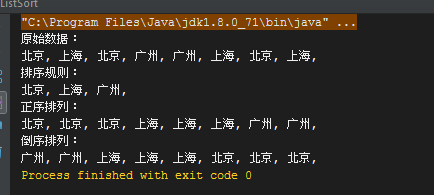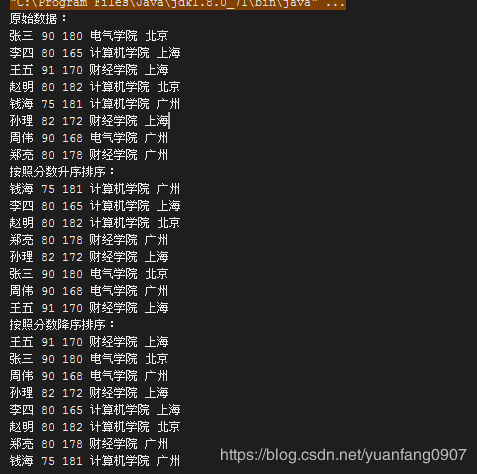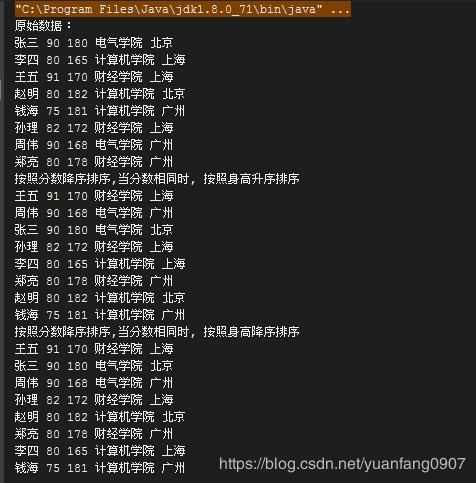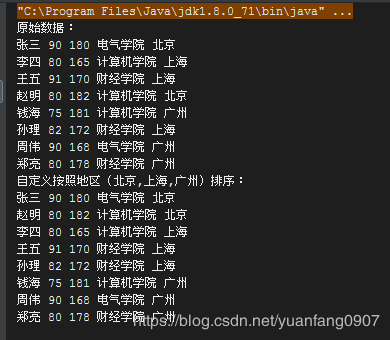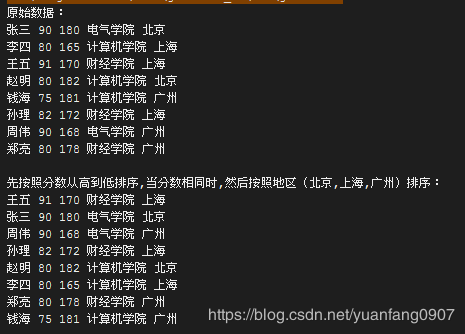List集合的各种排序
在Java编程中,经常要对List集合进行排序,因此对List排序的各种情况进行总结,希望对各位读者有所帮助。
1.单属性变量List排序
1.1按照变量属性升序,降序排序
/**
* 单属性变量list 自身属性升序, 降序排序
*/
private void singleVariableSort1(){
List list = Arrays.asList(10,1,6,4,8,7,9,3,2,5);
System.out.println("原始数据:");
list.forEach(n ->{System.out.print(n+", ");});
System.out.println("");
System.out.println("升序排列:");
Collections.sort(list); // 升序排列
list.forEach(n ->{System.out.print(n+", ");});
System.out.println("");
System.out.println("降序排列:");
Collections.reverse(list); // 倒序排列
list.forEach(n ->{System.out.print(n+", ");});
}
1.2按照自定义的顺序排序
/**
* 单属性变量list 自定义顺序排序
*/
private void singleVariableSort2(){
List list = Arrays.asList("北京","上海","北京","广州","广州","上海","北京","上海");
List sortRule = Arrays.asList("北京","上海","广州");
System.out.println("原始数据:");
list.forEach(n ->{System.out.print(n+", ");});
System.out.println("");
System.out.println("排序规则:");
sortRule.forEach(n ->{System.out.print(n+", ");});
System.out.println("");
System.out.println("正序排列:");
Collections.sort(list, new Comparator()
{
public int compare(String a1, String a2)
{
int io1 = sortRule.indexOf(a1);
int io2 = sortRule.indexOf(a2);
return io1 - io2;
}
});
list.forEach(n ->{System.out.print(n+", ");});
System.out.println("");
System.out.println("倒序排列:");
Collections.sort(list, new Comparator()
{
public int compare(String a1, String a2)
{
int io1 = sortRule.indexOf(a1);
int io2 = sortRule.indexOf(a2);
return io2 - io1;
}
});
list.forEach(n ->{System.out.print(n+", ");});
}
2.对象List排序
2.1按照对象单属性升序,降序排序
/**
* 对象单属性升序,降序排序
*/
private void entitySort1(){
//Student 的 list 集合
List students = new ArrayList<>();
students.add(new Student("张三",90,180,"电气学院","北京"));
students.add(new Student("李四",80,165,"计算机学院","上海"));
students.add(new Student("王五",91,170,"财经学院","上海"));
students.add(new Student("赵明",80,182,"计算机学院","北京"));
students.add(new Student("钱海",75,181,"计算机学院","广州"));
students.add(new Student("孙理",82,172,"财经学院","上海"));
students.add(new Student("周伟",90,168,"电气学院","广州"));
students.add(new Student("郑亮",80,178,"财经学院","广州"));
System.out.println("原始数据:");
students.forEach(s ->{
System.out.println(s.getName()+" "+ s.getScore()+" "+s.getHeight()+" "+ s.getCollege()+""+s.getAddress());});
System.out.println("按照分数升序排序:");
students.sort(comparing(Student::getScore));
students.forEach(s ->{
System.out.println(s.getName()+" "+ s.getScore()+" "+s.getHeight()+" "+ s.getCollege()+""+s.getAddress());});
System.out.println("按照分数降序排序:");
students.sort(comparing(Student::getScore).reversed());
students.forEach(s ->{
System.out.println(s.getName()+" "+ s.getScore()+" "+s.getHeight()+" "+s.getCollege()+""+s.getAddress());});
}
2.2按照对象多属性升序,降序排序
/**
* 对象多属性升序,降序排序
*/
private void entitySort2(){
//Student 的 list 集合
List students = new ArrayList<>();
students.add(new Student("张三",90,180,"电气学院","北京"));
students.add(new Student("李四",80,165,"计算机学院","上海"));
students.add(new Student("王五",91,170,"财经学院","上海"));
students.add(new Student("赵明",80,182,"计算机学院","北京"));
students.add(new Student("钱海",75,181,"计算机学院","广州"));
students.add(new Student("孙理",82,172,"财经学院","上海"));
students.add(new Student("周伟",90,168,"电气学院","广州"));
students.add(new Student("郑亮",80,178,"财经学院","广州"));
System.out.println("原始数据:");
students.forEach(s ->{
System.out.println(s.getName()+" "+ s.getScore()+" "+s.getHeight()+" "+s.getCollege()+""+s.getAddress());});
System.out.println("按照分数降序排序,当分数相同时, 按照身高升序排序");
students.sort(comparing(Student::getScore).reversed().thenComparing(Student::getHeight));
students.forEach(s ->{
System.out.println(s.getName()+" "+ s.getScore()+" "+s.getHeight()+" "+s.getCollege()+""+s.getAddress());});
System.out.println("按照分数降序排序,当分数相同时, 按照身高降序排序");
Collections.sort(students, new Comparator()
{
public int compare(Student student1, Student student2)
{
if(student1.getScore().equals(student2.getScore())){
return student2.getHeight() - student1.getHeight();
}else{
return student2.getScore() - student1.getScore();
}
}
});
students.forEach(s ->{
System.out.println(s.getName()+" "+ s.getScore()+" "+s.getHeight()+" "+s.getCollege()+""+s.getAddress());});
}
2.3按照对象自定义单属性的顺序排序
/**
* 对象自定义单属性的顺序排序
*/
private void entitySort3(){
//Student 的 list 集合
List students = new ArrayList<>();
students.add(new Student("张三",90,180,"电气学院","北京"));
students.add(new Student("李四",80,165,"计算机学院","上海"));
students.add(new Student("王五",91,170,"财经学院","上海"));
students.add(new Student("赵明",80,182,"计算机学院","北京"));
students.add(new Student("钱海",75,181,"计算机学院","广州"));
students.add(new Student("孙理",82,172,"财经学院","上海"));
students.add(new Student("周伟",90,168,"电气学院","广州"));
students.add(new Student("郑亮",80,178,"财经学院","广州"));
System.out.println("原始数据:");
students.forEach(s ->{
System.out.println(s.getName()+" "+ s.getScore()+" "+s.getHeight()+" "+s.getCollege()+""+s.getAddress());});
System.out.println("自定义按照地区(北京,上海,广州)排序:");
List addressOrder = Arrays.asList("北京","上海","广州");
Collections.sort(students, new Comparator()
{
public int compare(Student student1, Student student2)
{
int io1 = addressOrder.indexOf(student1.getAddress());
int io2 = addressOrder.indexOf(student2.getAddress());
return io1 - io2;
}
});
students.forEach( s ->{
System.out.println(s.getName()+" "+ s.getScore()+" "+s.getHeight()+" "+s.getCollege()+""+s.getAddress());});
}
2.4按照对象自定义多属性的顺序排序
/**
* 对象自定义多属性的顺序排序
*/
private void entitySort4(){
//Student 的 list 集合
List students = new ArrayList<>();
students.add(new Student("张三",90,180,"电气学院","北京"));
students.add(new Student("李四",80,165,"计算机学院","上海"));
students.add(new Student("王五",91,170,"财经学院","上海"));
students.add(new Student("赵明",80,182,"计算机学院","北京"));
students.add(new Student("钱海",75,181,"计算机学院","广州"));
students.add(new Student("孙理",82,172,"财经学院","上海"));
students.add(new Student("周伟",90,168,"电气学院","广州"));
students.add(new Student("郑亮",80,178,"财经学院","广州"));
System.out.println("原始数据:");
students.forEach(s ->{
System.out.println(s.getName()+" "+ s.getScore()+" "+s.getHeight()+" "+s.getCollege()+""+s.getAddress());});
System.out.println("先按照学院(电气学院,计算机学院,财经学院)排序, 当学院相同时,按照地区(北京,上海,广州)排序");
List collegeOrder = Arrays.asList("电气学院","计算机学院","财经学院");
List addressOrder = Arrays.asList("北京","上海","广州");
Collections.sort(students, new Comparator()
{
public int compare(Student student1, Student student2)
{
if(student1.getCollege().equals(student2.getCollege())){
int io1 = addressOrder.indexOf(student1.getAddress());
int io2 = addressOrder.indexOf(student2.getAddress());
return io1 - io2;
}else{
int io1 = collegeOrder.indexOf(student1.getCollege());
int io2 = collegeOrder.indexOf(student2.getCollege());
return io1 - io2;
}
}
});
students.forEach( s ->{
System.out.println(s.getName()+" "+ s.getScore()+" "+s.getHeight()+" "+s.getCollege()+""+s.getAddress());});
}
2.5按照对象属性自定义混合排序
/**
* 对象属性自定义混合排序
*/
private void entitySort5(){
//Student 的 list 集合
List students = new ArrayList<>();
students.add(new Student("张三",90,180,"电气学院","北京"));
students.add(new Student("李四",80,165,"计算机学院","上海"));
students.add(new Student("王五",91,170,"财经学院","上海"));
students.add(new Student("赵明",80,182,"计算机学院","北京"));
students.add(new Student("钱海",75,181,"计算机学院","广州"));
students.add(new Student("孙理",82,172,"财经学院","上海"));
students.add(new Student("周伟",90,168,"电气学院","广州"));
students.add(new Student("郑亮",80,178,"财经学院","广州"));
System.out.println("原始数据:");
students.forEach(s ->{
System.out.println(s.getName()+" "+ s.getScore()+" "+s.getHeight()+" "+s.getCollege()+""+s.getAddress());});
//先按照分数从高到低排序,当分数相同时,然后按照地区(北京,上海,广州)排序
List addressOrder = Arrays.asList("北京","上海","广州");
Collections.sort(students, new Comparator()
{
public int compare(Student student1, Student student2)
{
if(student1.getScore().equals(student2.getScore())){
int io1 = addressOrder.indexOf(student1.getAddress());
int io2 = addressOrder.indexOf(student2.getAddress());
return io1 - io2;
}else{
return student2.getScore() - student1.getScore();
}
}
});
System.out.println("");
System.out.println("先按照分数从高到低排序,当分数相同时,然后按照地区(北京,上海,广州)排序:");
students.forEach( s ->{
System.out.println(s.getName()+" "+ s.getScore()+" "+s.getHeight()+" "+s.getCollege()+""+s.getAddress());});
}

